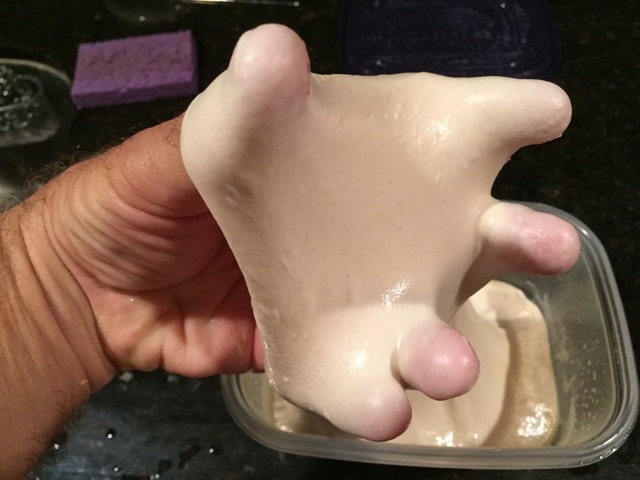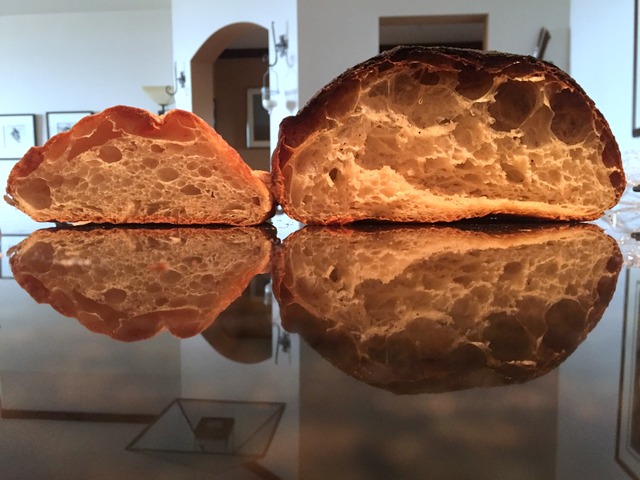To anyone even casually glancing at the most bookmarked pages on TFL, Jason’s Quick “Coccodrillo” (sp.) Ciabatta Bread is akin to the great thoroughbred Secretariat running against all puny comers. I’d been avoiding trying it out, for who knows why, but just this week adrianjm added to the list of those posting their version of the bread. So, I guess it was gravity that brought me to try it out too. And I did. Twice in one day.
The first time was a trial run to get my feet wet with this dough. And it certainly is quick, living up to its posted name. So quick in fact, that I probably over proofed because the dough is so active. A few other things too, on my trial run, revealed in the photos.
Because I thought that I could do better on a second try, I made some mods to the formula as laid out way way back in 2007 by LilDice, the O.P. And I liked the results a second time through a lot more.
I left the dough at 95% hydration, but substituted out 15g of water with 15g of olive oil, and also added ~3.5g of diastatic malt powder because I wasn’t happy with the pale shade of the first run, regardless of how long I left it in the oven to darken – it just never happened.
I find that, for my tastes, this bread doesn’t carry that heartier, sweeter and more developed flavor that a long fermenting or pre-fermented bread does, as this is a direct method bread, start to finish in a morning’s time. Nor does it have a robust enough crust for my personal liking. But it is tender and a bit sweet, will make excellent toast, bruschetta or croutons when it has aged for another day or so, and is a good addition to my growing folder of breads.
A few other changes as well, all part of the methodology, added at the tail end of this post.
With one hand in the dough and one on the camera, this is the best I could do for a photo of a good window pane.



Comparing the first, trial bake to the second modified bake. The earlier bake is pale and was more difficult to shape. From the crumb shot it is plain as day that it also had minimal loft.


Updated 6 Oct.
A new bake, but due to what I perceived to be a lack of depth of flavor in the bake above, I subbed out 150g of bread flour for 150g of semolina/durum flour. Otherwise just about everything was the same. Except that I decided to support the sides of the dough in a couche during the proofing, as I mentioned in the formula notes. One other thing was that the mixing took another few minutes longer, and I'll posit that this was from the introduction of the semolina flour.
As you can see, not only did I get a fantastic oven spring, which I did expect, but the top didn't just brown, it burned. It was as if there was too much of a good thing. And I'll take a SWAG at what it was. The too much, I'm going to guess, was that the diastatic malt powder was still in there. Perhaps the addition of the semolina requires the subtraction of the powder. So until I know better, as in running another bake without the powder, I'll take a leap of faith and say that is what it was.
The crumb still seems tender and pretty open, but I really didn't like how the open crumb mostly seemed to congregate at the top of the loaf. Now, how to balance out the best of the two bakes to build a better crocodile trap. We shall see...
Supporting the couche lined parchment:

Not quite charcoal briquet territory

The crumb is not nearly as dark as the cameras filter makes it to be.

When I mentioned that this bake had fantastic oven spring I'm not just Whistling Dixie. Here is a side by side with the remnants of the last bake, albeit a bit deflated by time. And that prior bake had great oven spring as the lead picture shows.

alan
Ciabatta
By Jason Molina
- 500g bread flour*
- 460g refrigerated cold water
- 15g olive oil
- 2 tsp. yeast
- 15g salt
- 5g diastatic malt powder
Total time: ~4 ½ - 5 hours
Method:
- In mixer with paddle: Mix all dry ingredients first to distribute. Add liquids and mix until combined, the consistency of a thin batter. Rest for 10-15 minutes.
- Mix on high speed with dough hook until dough separates cleanly from the bowl and slaps sides of bowl. Scrape down bowl and hook a few times during the mix. In my Kitchen Aid 4 qt. it took ~13 minutes total mixing time on speed #8, 2-5 more minutes on speed #6. Look for a strong window pane. If not well developed or breaks easily, mix dough more.
- Place into a well oiled square or rectangular container and let it triple in volume, <2 - 2.5 hours. Beware, that once this dough starts moving, it rises rapidly.
- Gently apply a 4 fold and flip dough inside container at 40 and 80 minutes.
- Empty onto a floured surface. Fold dough in half, squaring the shape if a rectangular container was used.
- Divide into 2 or 3 pieces. Use dough scraper to form the loaf shape. Keep shape short. Dust with flour.
- **Transfer loaves to a parchment covered oven peel. At this point, the dough can be gently stretched out to a longer length.
- Cover and proof for ~45 minutes.
- Preheat oven at 500dF. Sylvia’s Steaming Towels 15 minutes pre-bake.
- Load into oven from peel. Bake at 500dF with additional steam, about 25-30 minutes total. Release steam and rotate 180 degrees after ~12 minutes.
Notes:
- *Can substitute 150g semolina for 150g bread flour
- **Next time I may sit the parchment paper inside of a couche to support the sides of the dough so that it doesn't spread out as wide during the proofing.
- This is a 95% hydration dough, almost like batter until it comes together.
- Use cold water because of mixing friction.
- Keep an eye and hand on the mixer so that it doesn’t walk off the counter.
- Loading the dough onto the oven peel for proofing avoids unnecessary handling.